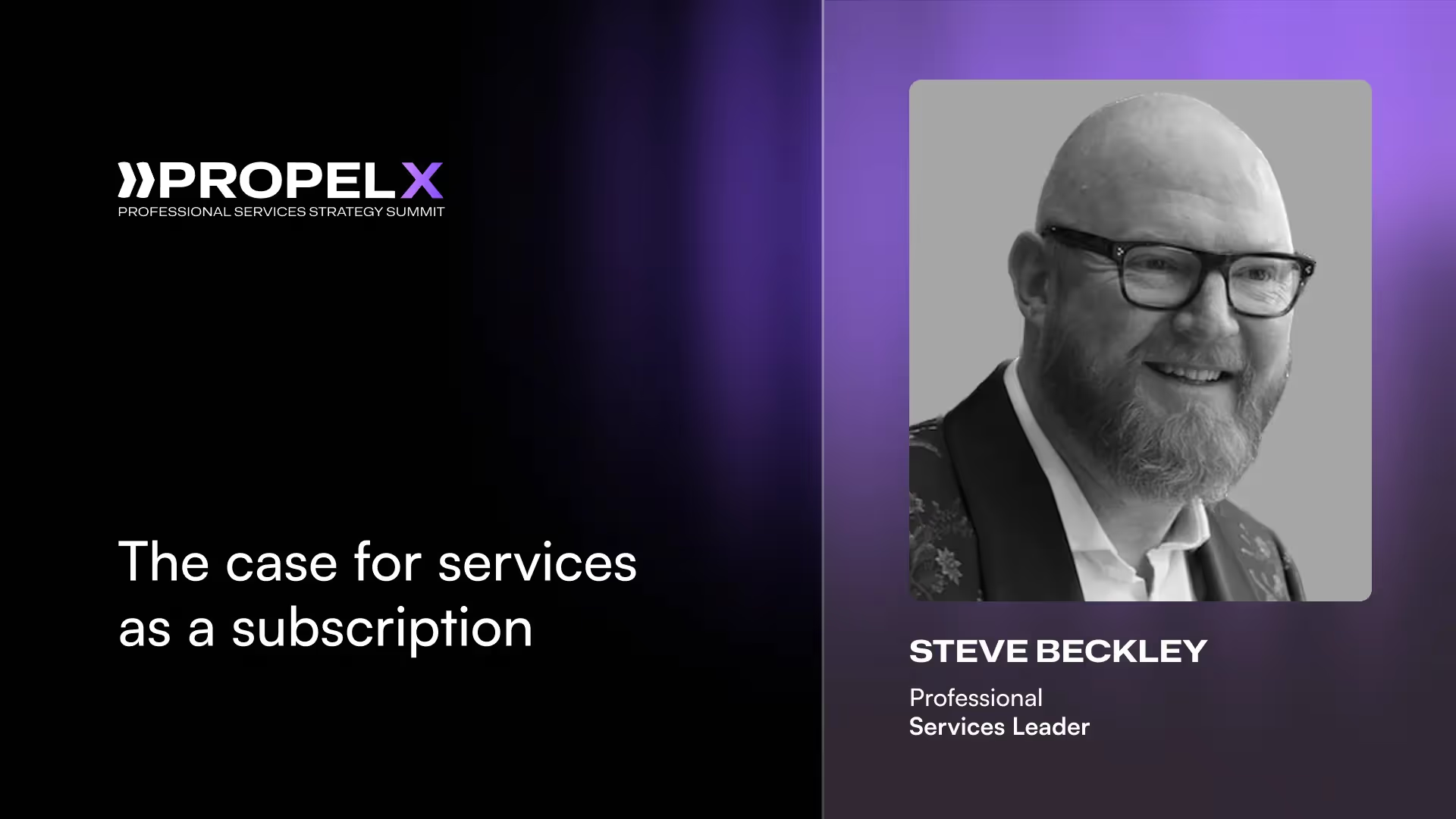Organizations are increasingly looking for innovative ways to enhance customer engagement while driving sustainable growth.
One emerging strategy is adopting a subscription model for professional services, which offers both recurring revenue potential and improved customer satisfaction. This shift has been particularly relevant for software-as-a-service (SaaS) companies, where integrating professional services can significantly elevate the overall customer experience.
{{demo}}
During the PropelX - Professional Services Strategy Summit, Steve Beckley, an industry expert with over 44 years of experience in IT shared his insights on the compelling case for transforming professional services into a subscription model.
The importance of professional services in SaaS
As many in the SaaS industry grapple with defining the necessity of services, it is critical to recognize the transformative power of professional services. For SaaS companies, converting traditionally one-time fees into recurring revenue through productized services can be a game changer. By establishing a framework where professional services are delivered as a subscription, organizations not only create consistent revenue streams but also enhance customer satisfaction. This model allows companies to provide ongoing value to customers, fostering long-term relationships and customer loyalty.
The benefits of transitioning to subscription-based professional services
Transitioning to a subscription-based model for professional services presents numerous benefits. From the vendor's perspective, this shift creates a more predictable revenue model, which is crucial for sustainable growth. It aligns with the SaaS ethos of delivering continuous value and encourages ongoing engagement with customers. For customers, subscription-based services offer the promise of regular updates, support, and enhancements, which can improve their overall experience and satisfaction with the product.
As the market shifts towards sustained customer engagement and continuous value delivery, SaaS companies have the opportunity to innovate their service offerings. Beckley’s experiences illustrate the practical value of this approach and underline the importance of adapting to evolving market demands.
Redefining service offerings
Beckley shared his experience of transforming the professional services landscape, reflecting on his time at a Norwegian video conferencing company during the early days of the COVID-19 pandemic. The company offered two products: a standard cloud-based video conferencing platform and a secure, on-premise solution that was highly sought after by government agencies and courts. Despite the potential for significant revenue through professional services, the company struggled to monetize these offerings, relying heavily on free pilot installations and lackluster sales efforts.
The inherent challenge lay in the company's structure, which discouraged the monetization of professional services due to the reliance on a channel distribution model. Beckley noted that this led to a frustrating situation where professional services generated less than $200,000 annually. The resistance to change within the company highlighted a common issue faced by many organizations: the difficulty in shifting established mindsets and practices, especially in a competitive landscape.
Innovating professional services for future growth
Determined to alter the trajectory of professional services within the organization, Beckley proposed a new model that would allow for the monetization of services while ensuring ongoing value delivery. His plan involved redefining the service offerings to align with customer needs and positioning them as essential components of the software purchase process. By shifting the narrative around professional services, Beckley aimed to create a sustainable revenue stream and enhance customer engagement.
Continuing from Beckley's innovative approach to transforming professional services, it's clear that adapting to a subscription model is not merely an operational change but a fundamental shift in mindset. Here are some strategies and insights that emerged from his experiences, emphasizing how organizations can successfully implement subscription-based professional services.
Aligning services with customer needs for maximum value
To effectively transition to a subscription model, it's essential to deeply understand customer requirements and pain points. Beckley emphasized the importance of conducting thorough market research and gathering customer feedback to redefine service offerings. By tailoring professional services to meet specific customer needs, organizations can position these offerings as indispensable components of the overall solution, rather than optional add-ons. This alignment not only enhances customer satisfaction but also ensures that services are seen as essential for maximizing product value.
Implementing tiered service packages to cater to diverse customer segments
Implementing tiered service packages can be an effective way to cater to different customer segments while driving recurring revenue. Beckley highlighted how offering multiple levels of service—ranging from basic support to comprehensive consultancy—can attract a broader audience and increase upselling opportunities. This approach enables customers to choose a service level that aligns with their budget and requirements, ultimately fostering long-term relationships.
Transitioning from one-time fees to recurring revenue
One of the most significant advantages of a subscription-based model is the predictability it brings to revenue streams. Beckley recommended phasing out traditional one-time fees in favor of subscription pricing. This transition not only stabilizes cash flow but also encourages organizations to continuously innovate and deliver value, as the success of the subscription model hinges on customer retention and satisfaction.
Encouraging customer engagement and feedback
Continuous engagement is vital for the success of subscription-based professional services. Beckley suggested implementing regular check-ins and feedback loops with customers to ensure their needs are being met. This ongoing dialogue not only allows organizations to make necessary adjustments to their service offerings but also strengthens the relationship with customers, making them feel valued and heard.
Overcoming internal resistance by fostering a culture of change
Transitioning to a subscription model often encounters resistance from within the organization, as teams may be accustomed to traditional practices. Beckley stressed the importance of cultivating a culture that embraces change and innovation. This can be achieved through leadership buy-in, effective communication, and highlighting the benefits of the new model to all stakeholders. Engaging employees in the transformation process can help mitigate fears and foster a sense of ownership over the changes.
Educating sales teams on value proposition
For a subscription model to thrive, it’s crucial that sales teams fully understand and articulate the value of professional services. Beckley advocated for comprehensive training sessions focused on equipping sales personnel with the necessary knowledge to effectively communicate the benefits of subscription-based services. This education empowers sales teams to position services as integral to the customer’s success, which can significantly enhance sales effectiveness and close rates.
A vision for subscription-based professional services
By redefining service offerings, building sustainable revenue models, fostering a culture of change, and equipping teams with the tools they need, companies can create a thriving ecosystem where professional services are not only a source of revenue but also a catalyst for customer satisfaction and loyalty.
Ultimately, the shift towards subscription models represents a profound opportunity for SaaS companies to innovate and differentiate themselves in an increasingly competitive landscape. As organizations adapt to this new paradigm, they will not only enhance their profitability but also cultivate lasting relationships with customers, paving the way for long-term success in the digital age.
Further reading
1. Transitioning your PS business to a subscription model
2. Subscription models demystified: Choosing the right approach for your professional service business
3. Benefits of professional services subscription model
Q&A
1. Who owns the renewal process?
The individual responsible for selling the expansion or renewal should handle the renewal process. In a previous experience, the renewal rate started at approximately 70%. Various strategies were implemented to improve this figure, ultimately leading to a renewal rate of over 85%. A key adjustment made was ensuring that the renewal opportunity was linked to the license renewal process. This integration facilitated discussions about renewals well in advance, reducing the chances of renewals falling through the cracks.
2. How should resources be managed over a three-year term for Professional Services (PS), and how can margins be maintained?
Managing resources over a three-year term can be challenging. During earlier phases, there was some freedom in resource management. The importance of providing value through self-service and automated resources was emphasized. By analyzing historical data on service demand, it was possible to establish estimates and adjust them as needed. Optimal margins may not be achieved in the first year, but subsequent years could yield better results. Avoiding excessive chargebacks is crucial for maintaining customer satisfaction, and it's important to ensure that services are not discounted disproportionately compared to software licenses.
3. What percentage of revenue from professional services is considered too much, particularly in relation to software product ARR?
Investors are often wary if services revenue exceeds a certain threshold. A professional services contribution of around 10% to 12% of ARR is generally acceptable while exceeding 25% could raise concerns. Building relationships with select customers rather than attempting to appeal to everyone is essential.
4. How does a higher ratio of professional services impact the go-to-market strategy?
A high reliance on professional services can delay customer onboarding, impacting the overall perception of the product. It is advocated to have a product that is easy to implement, allowing customers to become self-sufficient quickly. Achieving a balance where customers can deploy the product independently while also having access to valuable services is ideal.
{{demo}}






















.webp)
